The City and Waterfront Toronto are holding a public meeting to present an update on the future of the eastern section of the Gardiner Expressway.
Bluma Appel Salon
Toronto Public Library, Yonge North of Bloor
Thursday, February 6, 2014 from 6:30 pm to 9:00 pm
A media briefing on February 5 introduced the material, and there is widespread coverage in the mainstream press that I will not duplicate here. My interest lies more in the relationship of the expressway to travel demand generally, and to the importance of transit for the future development of central Toronto.
The media presentation contains information that will be included in the public meeting, and illustrations here are taken from that file.
The section of the Gardiner under study extends east from Jarvis Street to the Don Valley Parkway, plus the ramp down to Lake Shore Blvd. east of the Don River. It is important to remember what is not being changed.
- From Jarvis Street west, the existing expressway will be rebuilt under a multi-year program stretching to about 2019.
- The south end of the DVP will be modified only to the extent needed to connect in with whatever new or revised structure might be built.
- The ramp down to Lake Shore will remain in its current form except if the Gardiner is removed, in which case the ramp will be demolished and a new Lake Shore will cross the Don on a bridge at grade.
The Gardiner’s design capacity was scaled for connection to a future Scarborough Expressway that was never built, and the structure east of Jarvis is wider than is needed for the demand. This section gives the greatest opportunity for reworking, and releases the most land around the expressway in any new configuration.
The demand on this section is small compared with other parts of the expressway network to the north and west.
 Of the trips southbound on the DVP, 40% turn off at Richmond Street while the remaining 60% continue south, mostly bound for the Gardiner. Lake Shore Blvd. itself contributes to demand on the section between the Don and Jarvis. However, of the 4,500 AM peak hour trips on this road, almost 2/3 are bound for somewhere downtown. Only 1/3 are trips bound to points west.
Of the trips southbound on the DVP, 40% turn off at Richmond Street while the remaining 60% continue south, mostly bound for the Gardiner. Lake Shore Blvd. itself contributes to demand on the section between the Don and Jarvis. However, of the 4,500 AM peak hour trips on this road, almost 2/3 are bound for somewhere downtown. Only 1/3 are trips bound to points west.
 Eastbound peak traffic is even more concentrated west of Jarvis with 79% of inbound traffic leaving the expressway before it reaches the section under study.
Eastbound peak traffic is even more concentrated west of Jarvis with 79% of inbound traffic leaving the expressway before it reaches the section under study.
In both cases, the questions are:
- how much should be spent on infrastructure for the comparatively low number of through trips, and
- is a fully grade-separated road really needed here?
Although expressway users consider themselves a vital majority, the actual numbers for travel into the core don’t bear this out.
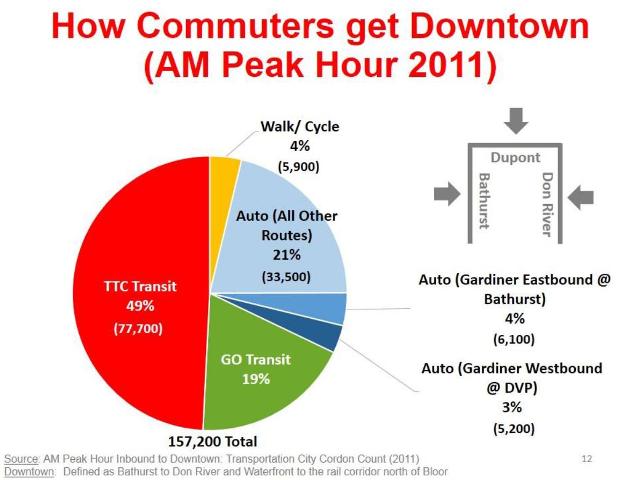 Of the AM Peak trips into downtown, 4% arrive from the Gardiner West. As we know from the destination chart above, most of these exit at or west of Jarvis, and they would not be affected by changes to the eastern section. 3% of trips arrive via that eastern segment. The vast majority of commute trips use transit (TTC/GO), cycle or walk into the core.
Of the AM Peak trips into downtown, 4% arrive from the Gardiner West. As we know from the destination chart above, most of these exit at or west of Jarvis, and they would not be affected by changes to the eastern section. 3% of trips arrive via that eastern segment. The vast majority of commute trips use transit (TTC/GO), cycle or walk into the core.
Development downtown continues both for residential and commercial space, and the rate of growth south of the rail corridor is running at a higher level than expected in earlier stages of the Gardiner study. This places additional demand on the transportation system as a whole, but there is no surplus capacity in the road network feeding into the core. The Gardiner West has been at capacity for decades, and demand from the north is constrained by the DVP where the inbound peak point is actually north of Bloor.
All of the growth that is expected over coming decades must be accommodated with improved transit and, to a lesser extent, cycling and walking.
The TTC section of this chart shows clearly the long stagnation in capacity to the core and the dropoff in demand with the mid-90’s recession. GO Transit has sustained growth, but it will carry less than half the riders of the TTC into the core even out to the 2031 projections. This occurs because development is shifting back downtown, and transit within the “416” will take up the bulk of the new ridership.
The presumed development for the demand model includes:
- Full build-out of the waterfront including the Port Lands over 40-50 years
- City population growth of 30%
- City employment growth of 30%
- Increase of downtown trips of 50%
This produces a capacity shortfall for transportation from the east regardless of what is done with the expressway.
Additional transit lines are essential to sustain growth in the core:
- The “Relief” subway line
- The Eastern Waterfront LRT line
- The Broadview extension and LRT south to Lake Shore
The question of building more transit is no longer one of “if” capacity will be provided, but “how soon”. Growth in the core will be strangled without more transit, and this message must be heard by those who take the attitude that “downtown has enough subways”. The additional demand cannot possibly be handled only by GO Transit, although it has a role to play.
Missing from these charts (because it is outside of the study area) is a view of the problems to the north and west of the core. That will be the subject of an Environmental Assessment to begin in March 2014 looking at both the Relief subway line and potential GO improvements such as the “big U” via the Stouffville and Weston corridors.
Population and employment growth downtown are both strong. The recession’s effect on employment is clear with the slowdown in employment from 1991 to 2001, but the trend is expected to swing upward. Population downtown was once under 1/3 of employment, but the proportion is pushing upward contributing to the rise in walking and cycling trips. That employment growth, of course, drives the additional transit demand, but without that transit, the growth cannot occur.
The four options for the Gardiner are:
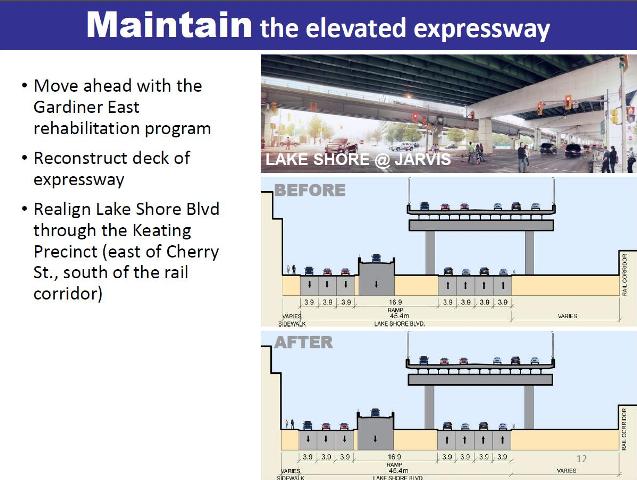 This version leaves the expressway more or less as it is with changes only to Lake Shore Blvd. to better integrate it with the proposed street plan of the revitalized waterfront.
This version leaves the expressway more or less as it is with changes only to Lake Shore Blvd. to better integrate it with the proposed street plan of the revitalized waterfront.
The “Improve” option has been simplified from the version presented in earlier public consultations in an attempt to lower its cost. Note that the Gardiner is reduced to two lanes each way in keeping with the capacity of the roads connecting to it.
 This option provides a new 4-lane expressway at a higher elevation than the existing structure to reduce the visual effect at street level.
This option provides a new 4-lane expressway at a higher elevation than the existing structure to reduce the visual effect at street level.
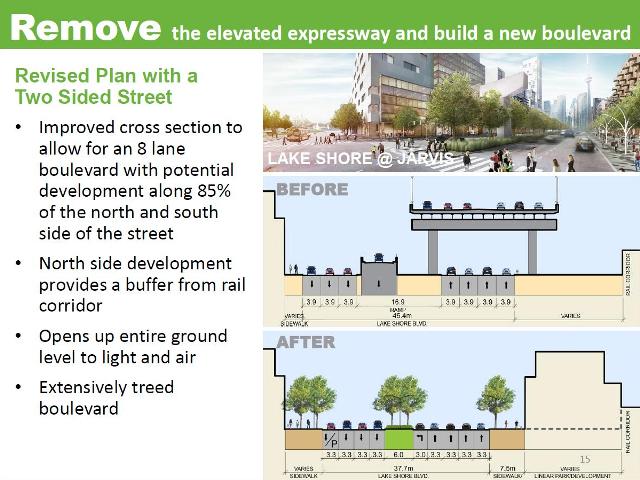 The “Remove” option consolidates the Gardiner and Lake Shore traffic onto one new boulevard at grade. The new road has four lanes each way plus a wide median and sidewalks.
The “Remove” option consolidates the Gardiner and Lake Shore traffic onto one new boulevard at grade. The new road has four lanes each way plus a wide median and sidewalks.
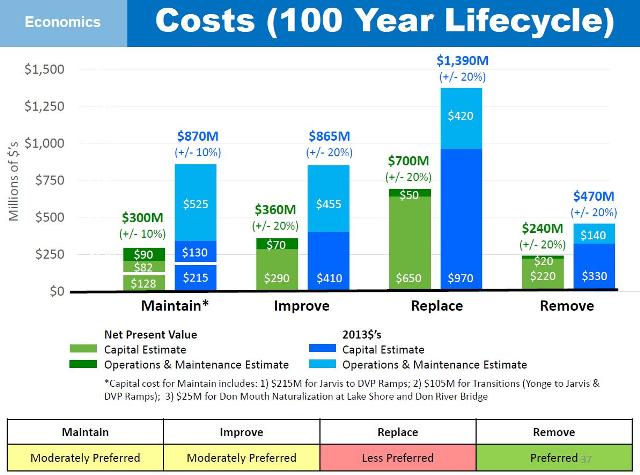 The “Remove” option is the least expensive on a life cycle basis because it is much less infrastructure-intensive. Ongoing operations and maintenance would be most expensive if the existing structure were retained in part because it would be larger than is needed for the demand. A new structure would be cheaper, but still over the long term would require substantial maintenance. Note that on a net present value basis, the relative magnitude of future maintenance costs is much smaller because most of them are discounted from decades in the future. The high capital cost of a new structure, however, cannot be avoided as a short-term expense. (Note that construction of any option will not start until about 2020, and so even the capital costs are discounted to present-day dollars.)
The “Remove” option is the least expensive on a life cycle basis because it is much less infrastructure-intensive. Ongoing operations and maintenance would be most expensive if the existing structure were retained in part because it would be larger than is needed for the demand. A new structure would be cheaper, but still over the long term would require substantial maintenance. Note that on a net present value basis, the relative magnitude of future maintenance costs is much smaller because most of them are discounted from decades in the future. The high capital cost of a new structure, however, cannot be avoided as a short-term expense. (Note that construction of any option will not start until about 2020, and so even the capital costs are discounted to present-day dollars.)
 Construction effects would be substantial, especially for the “Replace” option which would require a complete shutdown of both the Gardiner and Lake Shore for 8 years. Such an interruption is not practical, and “Less Preferred” as a ranking is an understatement. The shortest construction period would be for the “Remove” option which could be accomplished in two 18-month shutdowns, one for each direction.
Construction effects would be substantial, especially for the “Replace” option which would require a complete shutdown of both the Gardiner and Lake Shore for 8 years. Such an interruption is not practical, and “Less Preferred” as a ranking is an understatement. The shortest construction period would be for the “Remove” option which could be accomplished in two 18-month shutdowns, one for each direction.
No matter which option is chosen, there will be some impediments to drivers for a considerable period.
 Projected travel times raise the most concern among motorists who see their beloved Gardiner under threat by the “Remove” option. It is fascinating to contemplate that GO, Metrolinx and TTC might spend billions of dollars to make access to downtown easier, and yet the longer travel times for a small fraction of the commuting population would still dominate political debate.
Projected travel times raise the most concern among motorists who see their beloved Gardiner under threat by the “Remove” option. It is fascinating to contemplate that GO, Metrolinx and TTC might spend billions of dollars to make access to downtown easier, and yet the longer travel times for a small fraction of the commuting population would still dominate political debate.
The projected times are subject to review, and an obvious question must be why options other than “Maintain” increase travel times from Etobicoke to downtown. However, these are the numbers that have been published and they will set the tone for coming debates.
Which version do I prefer? That’s simple: remove this chunk of the expressway because its function can be substantially replaced by a much more attractive surface roadway. Toronto would not be the first city to do this, and it will certainly not be the last.
Can this option actually get through Council as it is now constituted? Very, very unlikely. But the whole thing will be back for another round in 2015 when detailed feedback from the EA is completed. The challenge will come if Council approves “Maintain” in 2014 and the EA proceeds only to look at that option in detail for the next year. A new Council may be faced with backtracking to make up for the partisan, shortsighted nature of today’s political environment.
What must not be forgotten in all the hand-wringing about disappearing road capacity is the much greater challenge for transit, and the threat that a focus only on the expressway will bring to the future development of Toronto’s core.

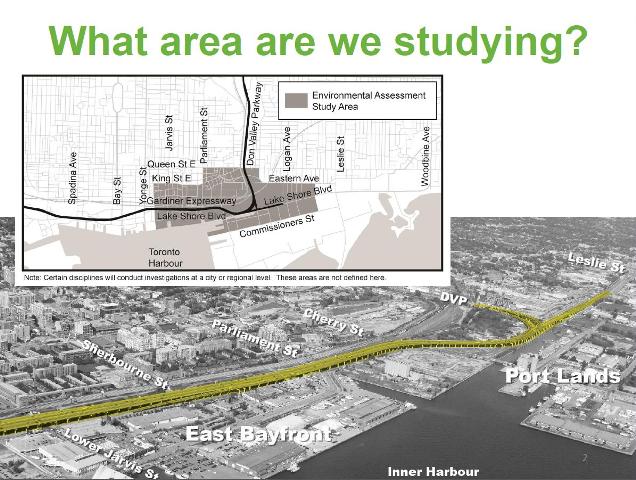
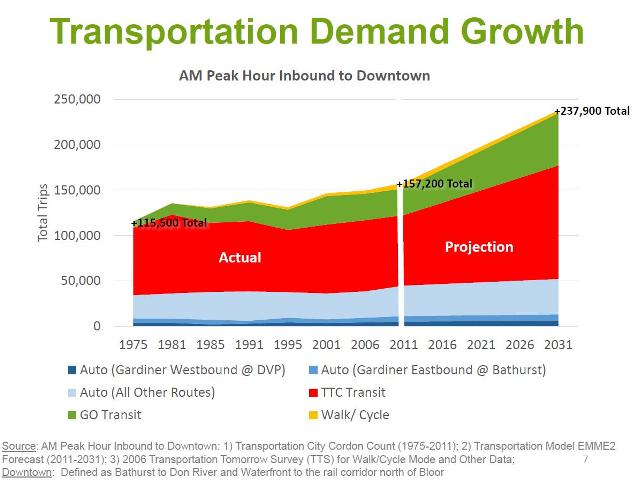


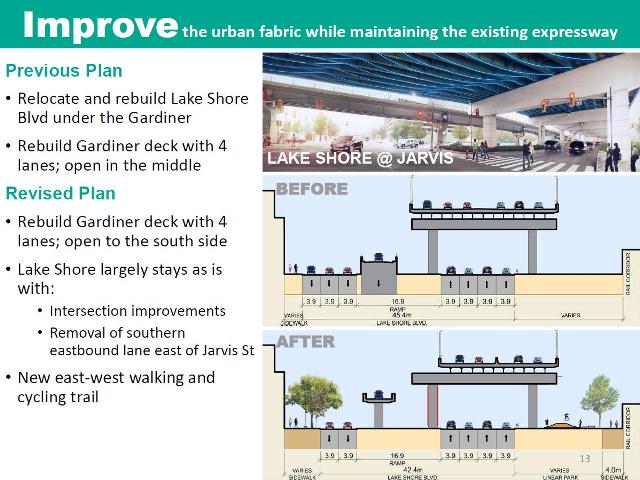
I live at the Jones & Gerrard area and drive to Milton for work. I use the Gardiner East EVERYDAY during AM & PM rush hour. In addition to this, my commute has been affected daily over the last 6 months due to the Gardiner East lane closures for repairs and the Leslie Street barns, so capacity has been constrained quite a bit more than what the REMOVE option is going to inflict on us, and it was fine.
So, even as a driver, I favour REMOVE. My comments below are anecdotal but should serve as a nice parallel to the data flying around
In the AM, westbound traffic through that stretch only slows down around the York ramp, and having done this everyday for the last 2 years, it only gets snarled up earlier if there is an accident. The York to Dufferin stretch is always congested, and if you are planning to drive 730-830, prepare for about 40 mins for the Jarvis to 427 stretch. I have never seen the eastbound lanes beyond Yonge be busy, unless there is an accident.
In the PM eastbound, even when there was only 2 lanes, the stretch east of Jarvis was a bit stop and go, but it added minutes, and there were alternatives to get to Lakeshore/Eastern/Queen/Kingston Rd. We are talking about having 4 lanes.
In the PM westbound, I do see that it’s much more congested than one would expect coming around the DVP horn and onto the deck, but this is usually due to problems farther ahead on the Spadina to 427 stretch.
In terms of the effect on the Lakeshore itself, it’s between 2 and 3 lanes from Woodbine over to the deck, and even in the thick of rush hour, you aren’t waiting more than 2-3 light cycles to get through in the AM. Right now it’s much worse with the barns construction so it’s further constrained. In the PM, the light cycle timing is done quite well (and they improved the left turns recently) so you get through quickly. I like the idea of the traffic signals “gating” congestion which has downstream impacts similar to having a variable speed limit on a road to avoid stop & go.
So, we seem to have done just fine with only a 2 lane Gardiner East section and reduced Lakeshore capacity. We are talking about 4 lanes in each direction and if there are only traffic lights at major intersections, I see this as a huge positive.
LikeLike
The more pertinent question would be if the projections are so far off, why should we rely on them to shape our decisions? While it would be a safe bet to assume that areas outside of downtown have fared worse that the core, it would also be a safe bet to assume that employment levels downtown are lower than projected. Furthermore it is going forward that we should worry about. The core is far to reliant on the F.I.R.E. sectors, in large part fueled by our housing bubble. If it does not continue, or crashes, what would the implications for downtown employment be?
Steve: And if the growth in downtown is less than projected, this will also affect future demand projections for roads, not just for the transit system.
LikeLike
That is indeed what I forgot. Do you have a reference to a website for these plans? Filling in waterways is serious work!
Steve: You can see a great deal of the redesign planned not just for Parliament Slip but other streets in the Lower Don and Portlands in the Keating Channel Precinct plan. Follow the links to various presentations, notably the July 24, 2013 public meeting.
LikeLike
On the topic of lane reversals, Calgary implements them on Memorial Drive, a boulevard with a somewhat wide median without the use of such expensive machinery.
See this page for more information.
I do think that lane reversals are somewhat unfriendly for pedestrians but might be a compromise to get pro-car people onside with the “Remove” option.
Steve: The problem with lane reversals is that they don’t work with the wide median planned for the surface road.
LikeLike
I suspect that our current rate of build, in terms of transit, and our ability to build in terms of road, we had better hope that the projections are too high for the right reasons. If the industries as a whole that feed downtown and Toronto have slowed down, then that buys time, if however, they are off because they are relocating, that presents issues that need to be addressed, especially if one of the drivers is commuting time. Since Finance, and Insurance on a world scale have slowed I would think this is the prime cause, and they should resume moderate growth again.
LikeLike